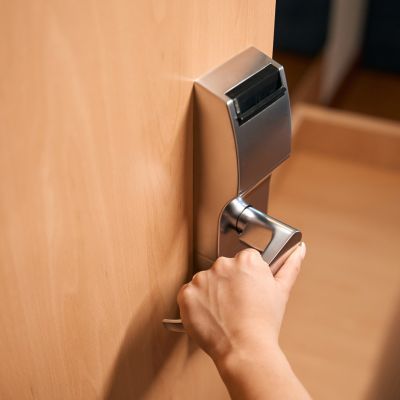Did you know that over 60% of customers prefer using self-ordering kiosks when dining at fast-food restaurants?
This growing trend shows how much people enjoy the convenience and speed of ordering their meals through these machines. As demands for speed, personalization, and convenience grow, self-service kiosks emerge as transformative tools, reshaping how customers interact with businesses.
Self-service devices can be found in a bustling hotel lobby, a quick-service restaurant, or a busy retail store. They give guests greater autonomy while offering hospitality providers a more efficient, cost-effective approach to serving them.
Southeast Asia is at the forefront of this digital shift, with hotels, restaurants, and retailers adopting self-service kiosks to improve service quality and operational efficiency.
The technology has proven versatility, from self-checkout kiosks in supermarkets to restaurant kiosks at popular eateries.
This article explores the various types of self-service kiosks in hospitality, their benefits, and critical considerations for their implementation.
What Are Self-Service Kiosks?
Self-service kiosks are digital machines that allow customers to place orders and make payments without help from restaurant staff. They are an essential part of the food ordering system in many modern restaurants.
A self-order kiosk allows customers to browse the menu, select items, customize their orders, and even pay—all through a simple touch screen.
From a customer’s perspective, using a self-ordering kiosk is straightforward. When they approach the kiosk, they can see the entire menu on the screen.
They can tap on the items they want, choose options like extra cheese or no onions, and even see a picture of what they’re ordering. Once their selection is complete, they proceed to payment by inserting a card, tapping a mobile wallet, or even paying with cash at some kiosks.
Many Singapore and Southeast Asian restaurants have adopted self-service kiosks to improve the dining experience.
For example, McDonald’s in Singapore has installed these kiosks in many locations, allowing customers to place orders quickly without waiting in line.
Similarly, popular chains like KFC and Burger King also use restaurant kiosks to speed up service and reduce wait times.
Types of Self-Service Kiosks in Hospitality
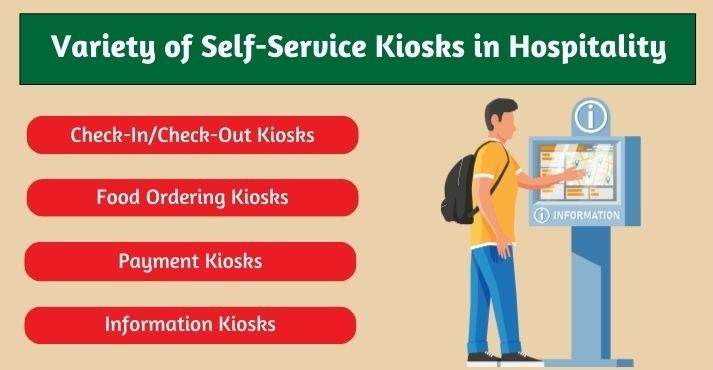
As the hospitality industry evolves, self-service kiosks have become essential tools, transforming how businesses interact with guests. These kiosks cater to various aspects of the guest experience, from hotel check-ins to restaurant orders—providing both convenience and efficiency.
It can be a guest arriving at a hotel eager to bypass the reception desk or a diner looking to customize a meal at a self-ordering kiosk; these devices offer smooth, user-friendly solutions that meet modern demands for speed and personalization.
This section will explore the primary types of self-service kiosks used in hospitality today. Each is designed to address specific needs and improve the customer experience.
1. Check-In/Check-Out Kiosks
One of the most common applications of self-service kiosks in hospitality is in hotel self-check-in and check-out processes. Self-check-in kiosks provide guests with a rationalized experience, allowing them to bypass the front desk and enter their information independently.
These kiosks are especially valuable during peak hours, reducing wait times and freeing staff to assist guests with more personalized needs. For travelers arriving at unconventional hours or in transit hubs, self-checkout kiosks increase convenience, enabling guests to complete their stay without additional formalities.
For instance, Changi Cove in Singapore has successfully integrated self-check-in kiosks to encourage guests to manage their arrival and departure autonomously.
With easy-to-use interfaces and multilingual support, these kiosks make international guests’ experiences more accessible.
In addition to cutting down on wait times, these kiosks help hotels maintain social distancing and adapt to guest preferences for contactless hospitality services—an essential aspect in today’s health-conscious environment.
2. Food Ordering Kiosks
Self-ordering kiosks have become popular in the food and beverage industry, especially in high-traffic areas like quick-service restaurants and cafes. These ordering kiosks enable customers to browse the menu, customize their orders, and pay directly without waiting in line.
With the rise of restaurant kiosks, customers have greater control over their dining experience, from selecting ingredients to choosing portion sizes, all while reducing the risk of human error in order taking.
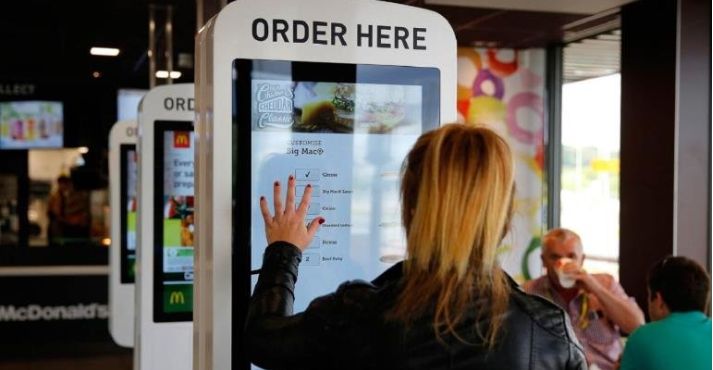
McDonald’s Self-Order Kiosk
For example, McDonald’s in Singapore has integrated self-order kiosks across many locations. These kiosks allow customers to place and personalize their orders and choose from multiple payment options, including mobile payments, credit cards, and loyalty rewards.
This adoption has improved order accuracy and customer satisfaction and increased average ticket sizes due to strategic upselling options available on the kiosk screens.
3. Payment Kiosks
Payment kiosks offer a simplified approach to hotel, restaurant, and retail transactions. When a self-service checkout option is provided, customers can quickly complete their purchases without waiting in line.
This is particularly useful in areas with high foot traffic, where managing payment queues can be challenging.
Kiosk machines equipped with payment options have become popular in retail and hospitality. They support multiple payment methods, including digital wallets and contactless payments.
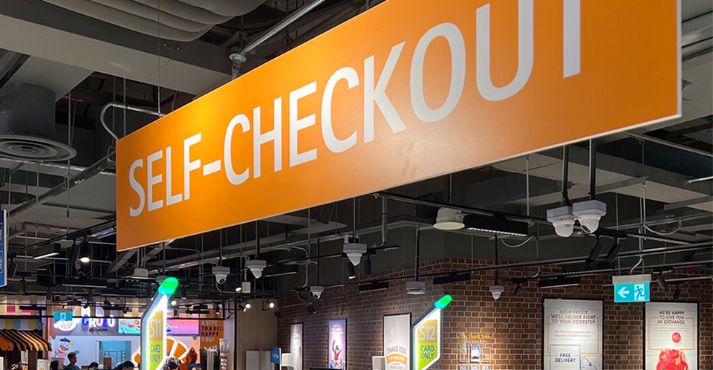
Self-checkout counters at NTUC FairPrice
Retail stores like NTUC FairPrice in Singapore use self-checkout kiosks to improve the shopping experience, allowing customers to scan, bag, and pay for items independently.
With the added convenience of digital payment options, customers enjoy a faster, hassle-free experience, and store staff can focus on other customer service roles.
In hotels, payment kiosks are valuable tools for reducing congestion at the front desk. They enable guests to pay for services, book amenities, or check out effortlessly.
4. Information Kiosks
Information kiosks act as digital concierges, providing guests with essential information about a venue’s facilities, services, and nearby attractions.
These kiosks can be found in hotel lobbies, restaurants, or convention centers. They can offer interactive maps, showcase event schedules, and highlight local attractions.
With the added benefit of multilingual support, information kiosks cater to a wide variety of guests, making it easy for international visitors to find relevant information in their preferred language.
Many hotels and tourist centers in Southeast Asia use information kiosks to support guests. These kiosks often detail city tours, nearby dining options, and local activities.
Benefits of Self-Service Kiosks in Hospitality
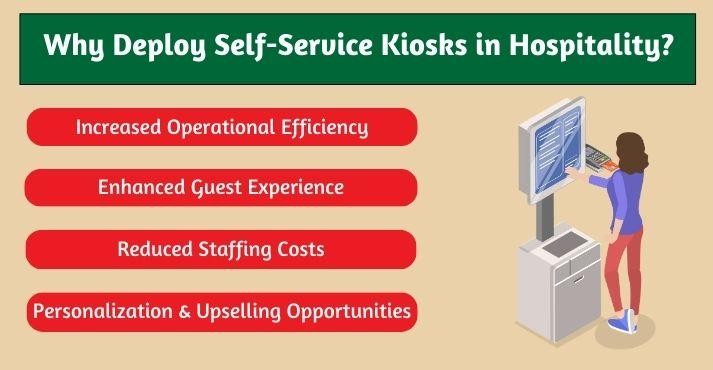
In the fast-paced world of hospitality, businesses constantly seek ways to improve efficiency and provide guests with a smooth experience.
Self-service kiosks have emerged as powerful tools for achieving these goals, offering benefits that improve day-to-day operations and elevate the overall guest experience.
Kiosks address the core needs of both guests and service providers, from cutting down wait times and reducing staffing costs to enabling personalized service and increasing revenue through upselling. Here, we explore the critical advantages of self-service kiosks in hospitality settings.
1. Increased Operational Efficiency
One of the most significant advantages of implementing self-service kiosks in hospitality is the marked improvement in operational efficiency.
When automating routine tasks like order-taking, check-in, and payment processing, kiosks free up employees to focus on more specialized or value-added roles.
In high-traffic environments, such as busy restaurants or hotel lobbies, self-ordering and self-check-in kiosks can significantly reduce wait times, creating a faster and more organized workflow.
- Increased Workflow for Restaurants: In restaurants, self-ordering kiosks transmit orders directly to the kitchen, eliminating the need for staff to relay orders and minimizing the chances of miscommunication or errors. This process speeds up food preparation and allows kitchen staff to prioritize orders in real-time based on demand and capacity.
- Streamlined Check-In Process for Hotels: Similarly, in hotels, self-check-in kiosks help guests manage their check-ins independently, leaving front desk staff available to address other customer needs. This efficient flow enables hotels to manage peak check-in and check-out times smoothly, even with high guest volumes.
In Singapore, popular fast-food chains like KFC and Subway have adopted kiosk ordering systems to manage high volumes of orders, particularly during peak hours.
These kiosks help reduce queue times and improve service speed by offering customers the option to place their orders independently.
2. Enhanced Guest Experience
Self-service kiosks provide flexibility and convenience that are increasingly appealing to modern guests.
Guests value the ability to interact with kiosks at their own pace without feeling rushed, particularly when making personalized decisions such as customizing a meal or selecting specific hotel amenities.
This sense of control over their experience increases guest satisfaction, especially for those who prefer minimal human interaction or are on a tight schedule.
In Singapore’s SATS Premier Lounge at Changi Airport, self-service kiosks enable guests to check in, choose from available amenities, and manage their services independently, creating a relaxed and efficient lounge experience.
These kiosks cater particularly well to business travelers and those with tight schedules, allowing them to make quick selections and move on to other tasks. The autonomy these kiosks provide is invaluable in today’s travel environment, where guests prioritize speed and convenience.
3. Reduced Staffing Costs
Another key benefit of self-service kiosks is the potential to reduce staffing costs, a crucial factor in industries experiencing labor shortages or fluctuating demand.
Automating routine and repetitive tasks, such as order-taking and check-ins, allows businesses to operate smoothly with fewer employees. This is particularly beneficial in the hospitality sector, where staffing costs represent a significant portion of operational expenses.
Many hotels facing staffing challenges in Singapore have turned to self-service kiosks as a cost-effective solution. These hotels maintain high service standards while optimizing labor costs when using kiosk machines for tasks like check-in.
This approach reduces the need for front-line staff. It allows businesses to direct remaining personnel to more specialized roles, such as guest relations or problem-solving, where human interaction is more impactful.
Additionally, self-checkout kiosks in retail stores, restaurants, and hotels offer guests a quick and easy way to complete transactions, reducing the need for cashier staff and shortening the time spent waiting in lines.
4. Personalization and Upselling Opportunities
Self-service kiosks offer significant opportunities for personalization and upselling. They leverage data and interactive interfaces to recommend additional services or items that boost the guest experience.
Through data collection and analysis, kiosks can tailor recommendations based on customer behavior, preferences, or previous purchases. This personalization provides guests relevant options and can boost revenue by encouraging add-ons or upgrades.
In restaurant kiosks, for example, this might include prompting customers to add popular sides, drinks, or desserts to their orders.
Many fast-casual dining spots in Singapore, like Mos Burger, use self-order kiosks to suggest menu items that complement the main order, such as a drink with a burger or fries as a side.
These subtle prompts allow guests to improve their dining experience while contributing to the restaurant’s overall revenue.
Suggesting relevant items and upgrades is also valuable in hotel settings. A kiosk ordering system in a hotel lobby might prompt guests to consider room upgrades, spa packages, or dining options.
Self-service kiosks can also collect data over time to refine these suggestions, making future interactions more tailored and effective.
When analyzing usage trends, businesses can adjust their upselling strategies to fit customer behavior patterns, improving the guest experience and the company’s bottom line.
Considerations for Implementing Self-Service Kiosks
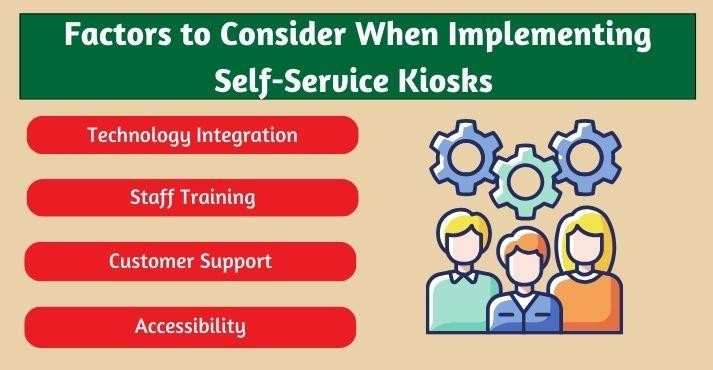
When implementing self-service kiosks, hospitality providers should carefully consider several factors to ensure successful integration:
- Technology Integration: The kiosk ordering system must align effortlessly with existing software and hardware, such as payment gateways and inventory management systems. An integrated system ensures smooth operation and heightens the overall user experience.
- Staff Training: Proper training is essential to help staff support customers using self-service devices. Employees should be able to assist with troubleshooting, answer customer questions, and manage kiosk maintenance as needed.
- Customer Support: Not all guests may be familiar with using kiosks. Offering guidance, such as on-screen instructions or a nearby staff member, ensures that all guests feel comfortable with the technology.
- Accessibility: To cater to a wide range of users, including those with disabilities, kiosks should meet accessibility standards, such as adjustable screens, multilingual support, and features like text-to-speech.
Conclusion
In the fast-evolving world of hospitality, self-service kiosks have emerged as powerful tools that elevate guest satisfaction and operational performance.
From self-checkout kiosks in retail to self-order kiosks in dining venues, these devices address modern demands for speed, convenience, and personalization.
For hospitality providers in Southeast Asia and beyond, investing in self-service kiosks is more than a trend—it’s a strategic move that increases efficiency, reduces costs, and creates a memorable guest experience.
As businesses continue to adopt hotel digital transformation, self-service kiosks will play an increasingly central role in shaping the future of hospitality.

